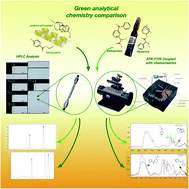FTIR combined with chemometric tools (fingerprinting spectroscopy) in comparison to HPLC: which strategy offers more opportunities as a green analytical chemistry technique for pharmaceutical analysis†
Abstract
Fourier transform infrared spectroscopy (FTIR) is a widespread technique that can provide a chemical signature (fingerprints) of solid, liquid, or gas samples with a wide range of analytical applications. High-performance liquid chromatography (HPLC) is a leading analytical strategy for pharmaceutical analysis. Here we present a side-by-side comparison of the potential of these techniques for quantitative analysis of pharmaceutical active ingredient combinations in light of green analytical chemistry (GAC) principles. The methods were successfully applied for the analysis of ketoprofen (KTP)/hyoscine (HYS) and benzocaine (BENZ)/dextromethorphan HBr (DEX) in their binary mixtures and pharmaceutical preparations. In FTIR analysis, calibration models were constructed based on partial least squares regression (PLSR) with satisfactory regression coefficients (r2) of 0.9998, 0.9994, 0.9855, and 0.9895 for KTP, HYS, DEX, and BENZ, respectively, over a wide linearity range (10–100, 10–100, 5–75, and 10–100 μg mL−1) that covers the concentration ratios in the market samples. External validation using a validation set and internal validation using leave-one-out-cross-validation calculations were performed, and small root-mean-square-error-of-cross-validation (RMSECV) values were obtained indicating the good resolving power of the models. The same performance was obtained using the HPLC method for separation of the same mixtures with r2 equal to 0.9998, 0.9999, 0.9998, and 0.9998 over linear ranges of 50–1000, 10–200, 5–100, and 5–100 μg mL−1 for KTP, HYS, DEX, and BENZ, respectively. The HPLC methods were validated following ICH guidelines with good recovery percentages in the range of 98–100%. The statistical comparison of the FTIR and HPLC methods for analysis showed almost the same results with good applicability towards commercial dosage forms. Concerning the twelve GAC principles, a detailed comparison was performed to highlight the opportunities of each technique. FTIR-PLSR analysis showed superior performance as it allows for less solvent consumption, portability, less generated waste, short operating time, less operation cost, less energy consumption, and more operator safety and it is easily coupled with chemometric tools. Besides, FTIR is a direct analytical technique that can be used for the analysis of samples in all the physical forms (solid, liquid, and gas) without modifications.



 Please wait while we load your content...
Please wait while we load your content...